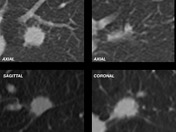Acinar-predominant adenocarcinoma of the lung
Updates to Article Attributes
Acinar-predominant adenocarcinoma of the lung is a histological subtype of non-mucinous invasive adenocarcinoma of the lung.
Terminology
In 2011, the International Association for the Study of Lung Cancer (IASLC), American Thoracic Society (ATS), and European Respiratory Society (ERS) 4 introduced a new classification and terminology for adenocarcinoma of the lung, which is now divided into 'preinvasive', 'minimally invasive', and 'invasive'.
The term bronchoalveolar carcinoma (BAC) has been retired, and it is recommended that all invasive adenocarcinomas be classified in terms of the "predominant" comprising histology 4. Both mucinous and non-mucinous adenocarcinomas typically consist of a mixture of histologic patterns, but reporting of the predominant subtype (lepidic, acinar, papillary, micropapillary, or solid growth) is specifically recommended for non-mucinous lesions, with all mucinous tumours placed in a separate category.
Treatment and prognosis
Acinar patterns are thought to have an intermediate prognosis but better than those associated with micropapillary, mucinous/colloid, and solid patterns and worse than those with lepidic predominant patterns 1,3.
-<p><strong>Acinar-predominant adenocarcinoma of the lung</strong> is a histological subtype of non-mucinous invasive <a href="/articles/adenocarcinoma-of-the-lung">adenocarcinoma of the lung</a>.</p><h4>Terminology</h4><p>In 2011, the International Association for the Study of Lung Cancer (IASLC), American Thoracic Society (ATS), and European Respiratory Society (ERS) <sup>4</sup> introduced a new classification and terminology for adenocarcinoma of the lung, which is now divided into 'preinvasive', 'minimally invasive', and 'invasive'. </p><p>The term <a href="/articles/adenocarcinoma-in-situ-minimally-invasive-adenocarcinoma-and-invasive-adenocarcinoma-of-lung">bronchoalveolar carcinoma (BAC)</a> has been retired, and it is recommended that all invasive adenocarcinomas be classified in terms of the "predominant" comprising histology <sup>4</sup>. Both mucinous and non-mucinous adenocarcinomas typically consist of a mixture of histologic patterns, but reporting of the predominant subtype (lepidic, acinar, papillary, micropapillary, or solid growth) is specifically recommended for non-mucinous lesions, with all <a href="/articles/invasive-mucinous-adenocarcinoma-of-the-lung-1">mucinous tumours</a> placed in a separate category.</p><h4>Treatment and prognosis</h4><p>Acinar patterns are thought to have an intermediate prognosis but better than those associated with micropapillary, mucinous/colloid, and solid patterns and worse than those with lepidic predominant patterns<sup> 1,3</sup>. </p>- +<p><strong>Acinar-predominant adenocarcinoma of the lung</strong> is a histological subtype of non-mucinous invasive <a href="/articles/adenocarcinoma-of-the-lung">adenocarcinoma of the lung</a>.</p><h4>Terminology</h4><p>In 2011, the International Association for the Study of Lung Cancer (IASLC), American Thoracic Society (ATS), and European Respiratory Society (ERS) <sup>4</sup> introduced a new classification and terminology for adenocarcinoma of the lung, which is now divided into 'preinvasive', 'minimally invasive', and 'invasive'. </p><p>The term <a href="/articles/adenocarcinoma-in-situ-minimally-invasive-adenocarcinoma-and-invasive-adenocarcinoma-of-lung-1">bronchoalveolar carcinoma (BAC)</a> has been retired, and it is recommended that all invasive adenocarcinomas be classified in terms of the "predominant" comprising histology <sup>4</sup>. Both mucinous and non-mucinous adenocarcinomas typically consist of a mixture of histologic patterns, but reporting of the predominant subtype (lepidic, acinar, papillary, micropapillary, or solid growth) is specifically recommended for non-mucinous lesions, with all <a href="/articles/invasive-mucinous-adenocarcinoma-of-the-lung-1">mucinous tumours</a> placed in a separate category.</p><h4>Treatment and prognosis</h4><p>Acinar patterns are thought to have an intermediate prognosis but better than those associated with micropapillary, mucinous/colloid, and solid patterns and worse than those with lepidic predominant patterns<sup> 1,3</sup>. </p>
Image 1 Annotated image ( create )








 Unable to process the form. Check for errors and try again.
Unable to process the form. Check for errors and try again.